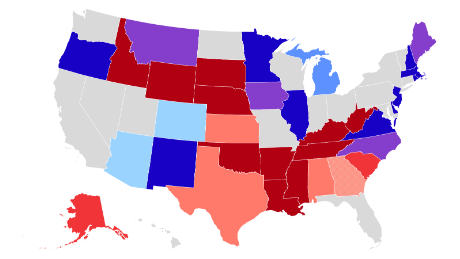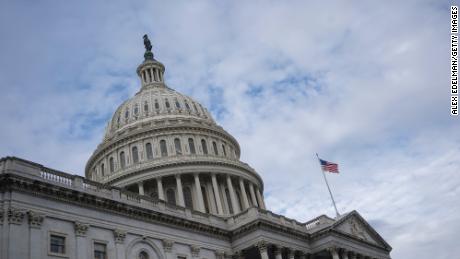Justice Ginsburg’s death has drawn scrutiny on some down-ballot races. Here are ratings for contests that could have long-lasting consequences.
According to Inside Elections, six Republican-held Senate seats currently rate as Tilt Democratic or Toss-up. In Arizona, Sen. Martha McSally is running against Democrat Mark Kelly, a former NASA astronaut and the husband of former Rep. Gabrielle Giffords. Colorado Sen. Cory Gardner, meanwhile, is facing off against former Gov. John Hickenlooper in a Democratic-leaning state. Both contests are rated Tilt Democratic.
A favorable map
Democrats are also benefiting from not having to play much defense this cycle. Of the dozen Democrats up for reelection this year, only the two running for reelection in states Trump carried in 2016 — Alabama Sen. Doug Jones and Michigan Sen. Gary Peters — face competitive contests, according to Inside Elections. Jones has the far more difficult challenge, with his matchup against former Auburn University football coach Tommy Tuberville rated as Lean Republican. The contest between Peters and John James, an Army veteran who lost a bid for Senate in 2018, is rated as Lean Democratic.
As things stand today, Inside Elections currently projects Democrats to pick up between three and five seats, which, depending on the results of the presidential race, could be enough to gain control of the Senate as well. With 43 days until Election Day, that is still plenty of time for the political winds to shift, particularly given the uncertain road ahead with the court vacancy.
Recent Senate ratings changes
In the wake of Ginsburg’s death and McConnell’s commitment to giving Trump’s nominee a vote, there’s even more attention on Graham, the chairman of the Senate Judiciary Committee.
Inside Elections shifted South Carolina’s Senate race one step further from the solidly Republican category, where the third-term senator has normally sat in his previous reelections, from Likely Republican to Lean Republican on Friday — before Ginsburg’s death.
Graham, a close ally of the President, still has the advantage in this red state that Trump carried by more than 14 points in 2016. But Harrison, a former state Democratic Party chairman, is outraising and outspending Graham — and he’s starting to attract the involvement of national allies, like the Democratic Senatorial Campaign Committee, which announced a seven-figure coordinated investment with his campaign last week.
Harrison’s quest to unseat Graham has long generated national headlines disproportionate to the race’s competitiveness. That may be changing, although the next few weeks will be worth watching. The fight over Ginsburg’s replacement not only shines a light on Graham’s role as chairman — and the heat he’s facing for backtracking on previous comments about not confirming a Supreme Court nominee during a presidential election — but it also has the potential to drive South Carolina voters into their partisan corners, which would help the incumbent.
Battle for the House
For all the drama surrounding the Senate, Democrats appear poised to keep their House majority next Congress as the party seeks to make gains in suburban-based districts and finds many of its frontline members in districts Trump carried in 2016 holding advantages heading into the fall.
For Republicans, the path back to the majority would start with the 30 districts held by Democrats that Trump carried on his way to the presidency four years ago. Many of those potential targets, however, remain a challenge, as Democratic incumbents hold overwhelming fundraising advantages while their GOP opponents have struggled to make the contests more competitive.
Inside Elections currently rates 205 seats as safe for Democrats, which would put the party just 13 seats away from keeping control of the chamber. There are 164 seats that are Safe Republican, leaving a universe of 65 seats in play — 37 held by Republicans and 28 by Democrats.
Only 10 seats are rated Toss-up, the most competitive designation, with seven held by Republicans and three by Democrats. And while Democrats are seen as having an edge in four Republican-held districts, including two redistricted seats in North Carolina, the GOP is not favored in any Democratic-held districts at this point.
Recent House ratings changes
Of the GOP’s potential pick-up opportunities, one of their best shots could be Florida’s 26th District, which was one of two races that Inside Elections shifted away from Democrats on Friday.
Hillary Clinton won this South Florida district in 2016, but the Cuban-American community’s embrace of Trump could move it away from Democrats. Freshman Rep. Debbie Mucarsel-Powell, who unseated GOP Rep. Carlos Curbelo in the 2018 midterms, is no longer in a Tilt Democratic race. Her campaign against Miami Dade County Mayor Carlos Gimenez, himself a Cuban American with a high profile, is now a Toss-up.
The other four ratings changes, however, are all in Democrats’ favor. A tightening presidential race in Arkansas’ 2nd District, which backed Trump by 10 points in 2016, could help Democrats unseat GOP Rep. French Hill. His race shifted from Likely Republican to Lean Republican.
Two suburban seats where Democrats are on defense edged closer to them. Democratic Rep. Sharice Davids flipped Kansas’ 3rd District two years ago, but Kansas City-area voters are quickly moving away from Republicans. Inside Elections moved the race from Lean Democratic to Likely Democratic. It’s a similar story in the suburbs north of Dallas, where freshman Rep. Colin Allred has a strong financial advantage over his GOP opponent, contributing to Inside Elections shifting Texas’ 32nd District from Lean Democratic to Likely Democratic.
Although it’s not at all like the suburban seats described above, Maine’s 2nd District also shifted in Democrats’ favor. Trump’s 2016 victory here earned him an electoral vote, but he’s not expected to do nearly as well in the White working class district against Biden as he did against Clinton. And Democratic Rep. Jared Golden, a Marine veteran who flipped the district in 2018, has a financial advantage over his GOP opponent, who’s hurting for cash. The 2nd District will get plenty of attention at the presidential, Senate and House level and see lots of outside spending, but Golden has a strong profile for the rural district. Inside Elections moved the race from Tilt Democratic to Lean Democratic.
![]()






